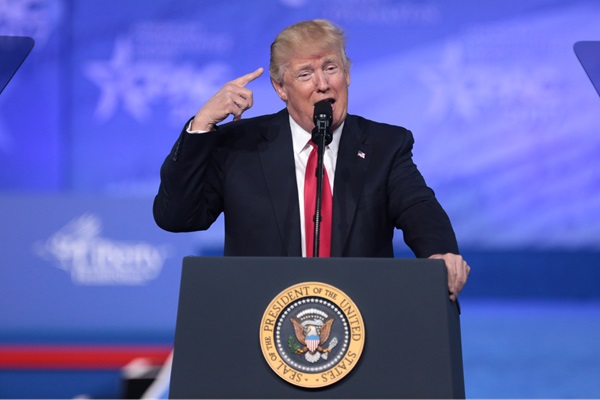.png)

Ajay Srivastava, founder of Global Trade Research Initiative, is an ex-Indian Trade Service officer with expertise in WTO and FTA negotiations.
May 4, 2025 at 1:43 PM IST
The United States has succeeded in painting India's tariffs and rules as the cause of the US trade deficit, thereby demanding that India buy more American goods, oil, and weapons, and dilute regulations that restrict the Indian operations of Google, Meta, Amazon, Walmart, Tesla, and other US firms.
The reality is that India pays more dollars to the US than it gets back, and the overall economic balance favours America. The picture changes completely when you include US arms sales to India, profits and royalties earned by American banks and companies, the free access US tech giants enjoy in India, and over $15 billion spent by Indian students each year on education in the US.
For every iPhone sold at around $1,000 in the US, Apple earns over $450, while India's share is less than $25. Yet in trade data, the full value is counted as an export from India, adding to the US trade deficit.
Instead of challenging the US narrative, Indian officials urge companies to cut imports from China and buy more from the US.
Finalisation of the Terms of Reference for the FTA was announced on April 21. ToRs set the ambition levels for the agreement. For example, in the India–EU FTA, the ToRs state that tariffs on goods covering 90% of trade value may be eliminated.
While the official ToRs for the US FTA are not public, we can make an educated guess. Since the US does not have Fast Track Authority, it cannot easily cut tariffs. This means that even after the FTA is signed, Indian exports to the US may still face current import duties and a base 10% tariff on most products. In contrast, the US could push India to remove tariffs on agricultural products and automobiles, and may also seek to limit Chinese inputs in Indian exports.
The US may demand more concessions from India in tariff and domestic policy space without offering much in return. It may also demand Forward MFN—meaning if India offers better treatment in any area to a new FTA partner, the same treatment would be extended to the US as well.
India's unilateral concessions and silence have allowed Washington to dominate the perception battle. This, in turn, helps the US seek more concessions from India in the ongoing free trade agreement negotiations.
So, what exactly does the US want from India in trade talks?
As trade negotiators from India and the US meet for the next round of FTA talks, Washington will be pushing for sweeping changes in India’s policies—ranging from tariff reductions to regulatory overhauls—that could benefit American firms and exporters.
The US National Trade Estimate Report for 2025 outlines Washington’s likely key demands.
These go beyond lowering tariffs to dismantling what the US refers to as non-tariff barriers—rules it claims unfairly limit access for American products and companies.
At the heart of US complaints is India’s high-tariff regime. Washington cites duties as high as 150% on alcoholic beverages, 100% on walnuts and coffee, and 60% on automobiles. It argues that such tariffs are excessive and non-transparent.
India counters that its tariffs remain within WTO-bound levels and are essential to supporting domestic producers in a developing economy. Frequent tariff adjustments, Indian officials argue, reflect the need to protect local industries from global market volatility.
Beyond tariffs, the US also objects to India’s complex policy and licensing regimes and discriminatory technical standards.
Agriculture is among the most contentious sectors. The US demands major reforms—including scaling back India’s minimum price support programmes for crops such as rice and wheat, removing restrictions on genetically modified imports, and lowering farm tariffs.
Washington criticises India’s frequent bans on pulse imports and its extensive public stockholding for food security purposes, calling them trade-distorting practices. India, however, fiercely defends its agricultural policies. Experts argue that dismantling MSP and procurement programmes would destabilise rural livelihoods in a country where half the population depends on agriculture. India points to the WTO’s "peace clause", which protects its food security programmes from legal challenges.
Similarly, on dairy, the US argues that India’s GM-free feed certification and facility registration protocols effectively bar American dairy imports. Indian rules prohibit imports from animals fed with animal-derived feed—for example, butter from a cow fed meat—due to religious sensitivities. India considers this policy non-negotiable.
Washington is also challenging India’s approach to pharmaceutical patents. Section 3(d) of India’s Patents Act bars patents for minor variations of existing drugs unless significant therapeutic benefits are demonstrated. The US pharmaceutical industry claims this policy stifles innovation.
India defends its stance as a necessary safeguard against "evergreening"—the practice of extending patent monopolies on marginally improved drugs—which would keep medicines unaffordable for its vast population still grappling with major public health challenges.
Digital trade has emerged as a new front. The US criticises India’s 2018 regulation mandating the local storage of payment data, arguing that it raises costs and disadvantages foreign firms.
India defends these policies as crucial for ensuring data sovereignty and promoting indigenous technology platforms. Measures such as capping the market share of foreign players like Google Pay and WhatsApp Pay at 30%, and promoting its Unified Payments
Interface, are framed as necessary to prevent monopolistic practices and encourage healthy competition.
Additionally, American retail giants such as Amazon and Walmart face roadblocks due to India’s restrictions on foreign-owned inventory-based e-commerce. Washington seeks to overturn these curbs, enabling direct sales to Indian consumers.
India resists, arguing that protecting small domestic retailers from unfair competition by deep-pocketed foreign firms is essential. It also views these restrictions as part of preserving regulatory autonomy in a fast-evolving sector.
Among other items on the US’s negative list are India’s allegedly costly and slow licensing requirements for remanufactured and second-hand capital goods. India mandates technical certificates, enforces quantity restrictions, and demands a residual life guarantee of at least five years for such imports.
India maintains that distinguishing between new and remanufactured products is crucial to prevent the dumping of obsolete technologies and to protect local manufacturing.
Washington has also expressed frustration over India’s ban on ethanol imports for fuel blending, in-country testing requirements under the Mandatory Testing and Certification of Telecom Equipment, and licensing requirements for laptops, tablets, and servers.
US exporters are also critical of India’s "Make in India" procurement policies. These reserve public contracts below $31 million for domestic firms and impose minimum local content requirements across sectors such as electronics, solar, and mobile phones.
India defends these policies as comparable to America’s own "Buy America" provisions and sees them as vital for building domestic manufacturing capacity. India is not a signatory to the WTO Government Procurement Agreement and maintains its sovereign right to design procurement policies in support of developmental goals.
Similarly, Washington objects to mandatory offset requirements on defence procurements, which require foreign suppliers to reinvest 30% of contract value into India’s defence ecosystem. India argues that such offsets are standard international practice aimed at building critical technological capabilities.
As for services and investment, the US seeks broader access to India’s services market, targeting foreign direct investment caps in retail, insurance, law, accounting, and banking. It also calls for lifting restrictions on foreign law firms and accounting firms operating in India.
India, however, argues that these restrictions are crucial to protecting traditional business models and ensuring regulatory oversight. It frames the caps as part of a calibrated strategy to liberalise gradually while safeguarding economic stability.
India must tread carefully. Committing to a sweeping FTA under current uncertain global conditions could undermine key national interests. A limited, industrial-goods-only pact would be a far safer and smarter move.




